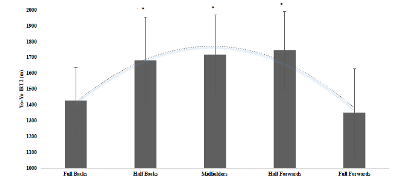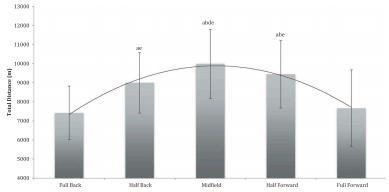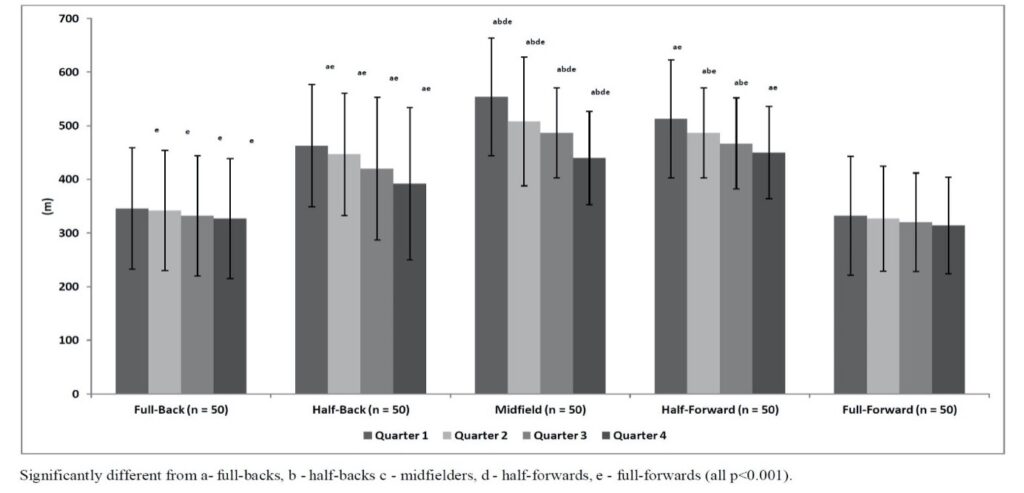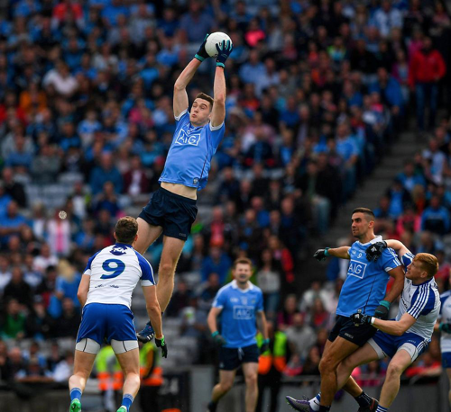Although an amateur sport, modern day elite Gaelic games athletes follow a quasi-professional training regimen. Players may be required to attend pitch-based sessions up to three times a week, gym-based resistance-training sessions twice a week, squad meetings and workshops. Commuting and participating in competitive or friendly games can mean several hours travel to and from venues, including overnight stays. This must be balanced with the demands of their personal and professional lives [4]. The commitment and dedication are unlike many sports, but what actually makes a GAA player, and what separates the elite, from sub elite? Here’s what the research says.

Lee Chin
Player Profile
An elite Gaelic footballer’s height typically ranges from 178 – 187cm [18, 21, 23], with body mass ranging from 81.0 – 83.6 kg [21, 23]. Body composition is an important characteristic of Gaelic games as lower body fat % is associated with increased speed, improved power to weight ratio, improved jumping ability and improved economy of movement across match-play [6, 9]. The body fat % ranges of elite adult Gaelic footballers are 10.9 – 11.3% [7, 20], while the average for sub-elite (club) players being 15.7 % [6]. Given these reports, body composition of Gaelic footballers appears to be an important factor in determining the level of competition one competes at.
Elite level GAA requires an athlete to jump, sprint, change direction and to execute all of these explosive actions repeatedly and effectively over a full 70+ minute game. As a result of our new understanding the requirements, performance assessments have become common practice. Gaelic footballers are required to contest duels in the air for possession during competitive match-play, thus the need to possess adequate power characteristics such as jump height. The mean countermovement jump height for elite Gaelic footballers ranges from 38.0 – 38.6 cm [9, 23].
Speed and acceleration are also crucial characteristics of Gaelic football [31]. During match-play it is often these short bursts of anaerobic activity that have an important bearing on match outcome [10]. The mean acceleration times for elite Gaelic footballers over 5, 10 and 20 meters are 1.10 s, 1.82 s and 3.09 s [23]. Fairly quick. The intermittent nature of Gaelic football can result in short recovery periods in between moderate- to high-intensity bursts [19]. It’s common for Gaelic footballers to complete Yo-Yo Intermittent Recovery Tests (Yo-YoIRT) in order to analyse their ability to perform repeated bouts of high intensity running [1]. The average Yo-YoIRT level 1 distance for elite minor Gaelic footballers is 1,446 – 1,503 m [5]. Elite Gaelic footballers are reported to complete 166 ± 41 accelerations during match-play [21]. Therefore, variance in Yo-YoIRT level 1 performance between players may have a crucial impact on match performance. During the Yo-YoIRT level 2, the average distance for elite Gaelic footballers is 1,751 m [8].
Player Profile – Positional Differences
Midfielders tend to be taller compared to all other outfield positions [9], often followed by the goalkeeper [5], however minimal differences among the five outfield positions can occur [18]. Midfielders tend to have a higher body mass than half backs [18] and half forwards [9]. However, no body mass variation across position can also occur [23]. The middle three positional lines tend to have lower body fat % values compared to full backs and full forwards [9, 23], but again, this trend is not always the case [7, 22]. Regarding speed and jumps, positional differences are not typically observed. In terms of aerobic capacity, midfielders tend to exhibit the highest profiles, followed by half backs and half forwards, with full backs and full forwards typically having lower aerobic capacities.
The importance of improved aerobic performance profiles should not be underestimated by Gaelic football coaches, considering that these profiles have been associated with running performance during match-play [1, 3]. 1 km time trials are commonly used to assess aerobic fitness, with the average time for an elite Gaelic football player being 3.21 min. Midfielders tend to have the best times, significantly better than both full backs and full forwards [11].

Figure 1. Positional differences for Yo-YoIR2 performance in elite Gaelic football players [23]
Game Demands
Recent advancements of technology now allow for game demands and running performance to be investigated thoroughly using global positioning system (GPS) technology. From research using this GPS technology, the work rate of elite Gaelic footballers appears to match or outweigh that of similar football codes. Considering Gaelic football match-play duration is only 70 minutes, relative (per minute) distances covered are similar to those reported in longer duration sports, such as elite Australian football [4] and elite soccer [2].
Game Demands – Positional Differences
The middle three positions cover the greatest distance, and perform a greater volume of high-speed running (≥ 17km·h-1) in comparison to full backs and full forwards [14, 15]. Midfielders have the highest relative (per minute) distances compared to all other positions; while half backs and half forwards record higher values when compared to full backs and full forwards. In elite Gaelic football, Typical total distance figures are: midfielders (10,245 ± 1,972 m), followed by half forwards (9,464 ± 1,612 m), half backs (8,758 ± 1,543 m), full forwards (7,766 ± 2,173 m) and full backs (7,310 ± 1,163 m). These are displayed in Figure 2.

Figure 2. Positional differences in total distance in elite Gaelic football [18]
A similar hierarchal trend is evident for high-speed (≥ 17km·h-1) running distance, with midfielders running the greatest distance (1,921 ± 719 m), followed by half forwards (1780 ± 507 m), half backs (1780 ± 507 m), full backs (1,404 ± 533 m) and full forwards (1,248 ± 564 m) [17], which are displayed in Figure 3. Regarding sub-elite match-play, players are reported to cover a mean total distance of 7,145 m during a 60 min game. Due to differences in match duration between sub-elite and elite Gaelic football (60 min vs. 70 min) comparisons are most appropriate using relative (per minute) figures [24]. All sub-elite positions are found to cover less relative total distance (distance per minute) compared to elite footballers (full back, 95 vs. 112 m·min-1; half back, 113 vs. 137 m·min-1; midfield, 117 vs. 151 m·min-1; half forward, 122 vs. 144 m·min-1; full forward, 92 vs. 112 m·min-1) [13, 16]. On average, elite Gaelic footballers were observed to complete 166 – 181 accelerations during match-play, with very high-speed running (m; > 22 km·h-1) reported to be 445 – 524 m [12, 21]. The average peak speed achieved during elite match-play is 30.3 km·h-1 [12].

Figure 3. Positional match-play variations in high-speed running distance across quarters [12]
Conclusion
Gaelic games players are amateurs, with a professional ethos; training between three and sometimes six times per week, with weekly training and playing loads similar to professional players. Gaelic football and hurling are intermittent, high-intensity sports and thus, training should be designed with this in mind. Coaches nowadays have a great insight into the typical performance profile of Gaelic footballers at various grades and ages. Along with positional variations regarding movement demands and performance based characteristics existing within Gaelic games. Similarly, variations exist when comparing elite (inter-county) and sub-elite (club) characteristics. Such differences may be utilised as a benchmark to reach for sub-elite athletes with aspirations of competing at elite level.

Dublin’s Brian Fenton catching a high ball. Photo: Ray McManus/Sportsfile
The intention of this article was to paint the picture of the science behind modern Gaelic games athletes. The research still has a ways to go to portray fully what it takes to play GAA, but this is a window into it. With all of these measurements and metrics considered, our minds are drawn to how we prepare our players, which we’ll look at in the future. In preparation for sports performance, there are many ways to skin a cat, but one thing is for sure – with all things considered, these are super athletes and need to be treated like that.
This article was written by Eoghan Boyle for Elevate Performance.
Eoghan holds a BSc Sport Science and Health and is currently studying towards his MSc in sport science, specialising in elite Gaelic football performance & the profile of the substitute.

